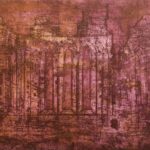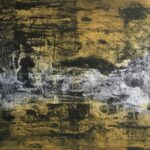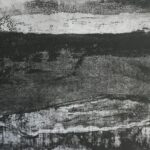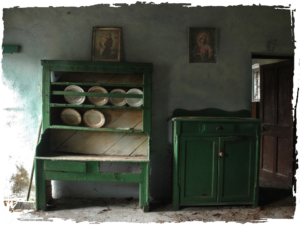
Last year, Liverpool Irish Festival presented an exhibition of etchings and monotypes by Northern Irish Wirral-based artist Martin McCoy. Shown at The Williamson Art Gallery and Museum, the exhibition took its inspiration from the medieval story Buile Suibhne. Taking motifs of the landscape described in the story, Martin’s prints provided a contemplation on our relationship to place. Additionally, they called on viewers to consider the role of location in shaping identity and influencing emotional states.
A year on, we caught up with Martin to ask him about his experience with Sweeney’s Unquiet Islands. Below, Martin reflects on responses to his exhibit and gives us an insight into the direction of his new studio work.
To recap Martin’s exhibition, readers can click here to view the exhibition catalogue.
Article contents
- Reflections: Sweeney’s Unquiet Islands one year on
- Places, deep mapping, layered interests
- Think, make, reveal
- Artist biography
- Hot Bed Press
In making the Sweeney series many themes emerged from the text. Not least was the experience of dispossession and isolation felt by those that have, for one reason or another, left their homes and their normal lives. Sweeney is forced to do the same in the story. Using my experience, I thought about what place meant for me. I thought, particularly, about my relationship to the north of Ireland (where I’m originally from) and its troubled history.
Although I left Northern Ireland over thirty years ago, I still retain a deep connection to its land and investment in its culture. I hoped that, in some way, the exhibition’s content might arouse similar emotions in the viewer about places that hold meaning for them, too. Many of the responses I had to the work -both during and since the show- seem to suggest that this was, to some degree, achieved.
Places, deep mapping, layered interests
Places are important to us. To quote from Pilgrimage, the first volume of Tim Robinson’s Stones of Aran[i]: “if we think of all the place names that humanity has applied to the surface of this planet as constituting a single vast fingerprint, can we neglect even its most minute particularities in trying to identify ourselves?”.
It is these minute particularities that hold so much interest for me. The manner in which they -in the gradual addition of physical and metaphysical layers over time- create our personal sense of place, wherever it may be.
The idea of ‘aspects beneath the surface’ often seems to drive my work. It’s a concept that resonates with the medium of printmaking. I see printmaking as palimpsest (the image being made of many effacing layers, through which you partially retain the view of another).
Influence and motive
Robinson’s work is certainly an important influence for me. The concept of ‘deep mapping’, with which Robinson’s work is very much associated, is “an attempt to record everything you might ever want to say about a place”[ii]. Although an impossible project, it motivates me to try.
I’m attempting to articulate my thoughts about where I come from in a visual language. Like Robinson’s, my outputs take shape in a somewhat oblique rather than dogmatic way. I hope this gives room for related themes and conversations to emerge. Through the choice of subject, and the rendering of motif, themes such as belonging, versions of nationhood and the experience of diaspora arise. In the case of Northern Ireland, the legacy of divided communities, the tragedy of lost cultures and the search for common ground -although perhaps not immediately obvious to the viewer- are never far from the surface.
Think, make, reveal
As a visual artist, the best place for my thinking is in the studio. It’s in the improvisatory act of making. The last year has been one of experimentation and development, across my print making and painting practices. The work is still very much in development, but builds on the techniques and ideas explored in the Sweeney series.
Techniques and their mission
Traditional soft ground etching and aquatint methods have been combined with colour experiments and mark making on multiple plates with the aim of creating layers of marks that suggest rather than illustrate. They’re an attempt challenge our traditional perceptions of landscape and what binds us to place. They invite viewers to take on a more imaginative and receptive state. They ask you to acknowledge the varied layers and poetry of place, rather than simply elicit nostalgia.
This process of studio improvisation, experiment and discovery, feels so central to making my making new work. It is perhaps best summed by the artist William Kentridge: “from the act of making, parts of the world and parts of us are revealed that we neither expected nor expressed until we saw them”[iii].
Martin has shared 12 images, set in to a gallery, below. Click on the first image to open the gallery show. Then, use your arrow keys (or select the arrows on either side of the gallery, with your mouse) to scroll through.
Artist biography
Martin McCoy (b. Belfast, 1967) studied fine art in Manchester (1985-1989), developing his practice in painting. In his early years, Martin’s primary focus became motifs of landscape and figure, with particular emphasis on working en plein air (outside). Although Martin remains based in Merseyside (North west England), he returns regularly to Ireland. There he maintains his connection with the Irish landscape, Irish history and contemporary Irish visual arts. He’s found that literature -and particularly poetry- has become increasingly important in the development of his practice.
Martin’s paintings incorporate traditional oils, as well as experiments with mixed media and collage. Printmaking techniques include intaglio printing processes, such as hard and soft ground etching; aquatint with spit-bite and sugar-lift; dry point and carborundum, often combining processes on a single plate. He is an active member of Hot Bed Press (Salford, UK) and studio member at Make Hamilton Square (Birkenhead, UK).
Hot Bed Press
Hot Bed Press (Salford) is one of the largest and best equipped open-access print workshops in the UK. They’ve been providing expert facilities, and support for printmakers, since 1994. As well as membership and access options they offer a range of courses in print and book arts. The large open-plan workshop boasts specialist facilities for screen-printing, etching, relief printing, letterpress and book arts, as well as 21 artists’ studios.
[i] Robinson, T. (2008). Stones of Aran: pilgrimage. London: Faber And Faber.
[ii] Gladwin, D. and Cusick, C. (2016). Unfolding Irish landscapes. Manchester University Press.
[iii] Kentridge, W. (2014). Six Drawing Lessons: the Charles Eliot Lectures, 2012. Cambridge, Massachusetts: Harvard University Press.


















